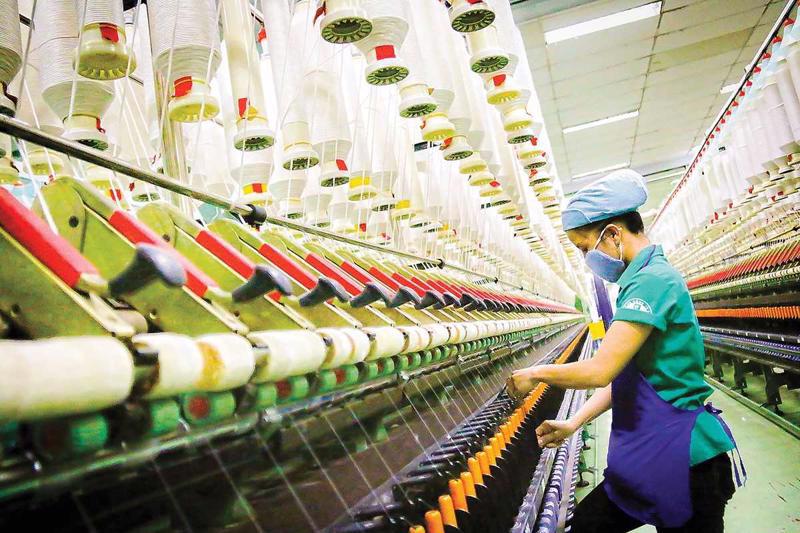The World Bank (WB)’s March edition of its Taking Stock report forecasts Vietnam’s real GDP growth at 6.8 per cent this year and 6.5 per cent next year. The main uncertainties in its growth outlook stem from slower-than-expected global growth and trade disruptions, particularly among Vietnam’s major trading partners.
“Vietnam is projected to maintain robust economic growth over the next two years, but it can use its fiscal space to better prepare for heightened uncertainties,” said Ms. Mariam J. Sherman, World Bank Director for Vietnam, Cambodia, and Lao PDR. “Growth-enhancing public investment, especially in urban, transport, and energy infrastructure, will be critical, provided authorities can scale this up and ensure that spending is efficient.”
Indicators slowing down
Vietnam’s trade activities in 2025 are expected to slow, with a potential decline to follow in 2026. Exports are projected to grow 12.1 per cent this year, while imports are forecast to rise by 12.7 per cent. While still representing handsome growth, this short-term slowdown in trade is primarily attributed to weakening demand from Vietnam’s two largest trading partners, China and the US, along with global trade uncertainties amid potential adjustments in trade policies.
Regarding inflation, the WB cautions that while inflation remains below the target, Vietnam should continue to exercise prudence. Stabilized food prices have helped keep inflation under control in 2024, with projections indicating it will remain at 3.5 per cent in 2025-2026, under the government’s limit of 4.5-5 per cent this year. Notably, despite ongoing conflict in Ukraine and the Middle East, crude oil prices are expected to fall further, contributing to inflation control.
Foreign investment and trade will continue to be key drivers of Vietnam’s economic growth over the next two years. FDI inflows are expected to remain stable in the short to medium term, supported by strong interest from international investors. With sustained FDI attraction, the WB forecasts that disbursed FDI in Vietnam could reach $25 billion in 2025.
Despite the slowdown in several economic indicators this year, Vietnam remains one of the fastest-growing and most-dynamic economies in Southeast Asia, according to Mr. Andrea Coppola, WB Lead Economist for Vietnam. “The government’s ambitious target of 8 per cent GDP growth in 2025 is entirely achievable, provided that global economic conditions remain favorable, policy support is robust, and Vietnam strengthens cooperation with its key trading partners,” he emphasized.
Rising uncertainties
While Vietnam’s economic outlook remains positive, the WB warns that the country will face three escalating uncertainties in 2025 and beyond.
First, trade-distorting policies implemented by some Southeast Asian countries, such as higher tariffs and measures that increase production costs in Vietnam, have been in place since 2015 and are continuing to rise. These policies not only affect the business environment but also pose risks to Vietnam’s GDP growth both this year and in the long term.
Second, the global economy may grow at a slower-than-expected pace, particularly in Vietnam’s key trading partners such as the US, China, and the EU. Shifts in trade policies, coupled with deepening fractures in international trade relations, could negatively impact Vietnam’s exports, especially in the manufacturing and processing sectors. This would not only affect industrial output but also challenge the country’s overall growth trajectory.
Finally, the recovery of the domestic economy, particularly the real estate sector, remains sluggish. Though the number of real estate projects have shown signs of improvement since late 2024, the pace of recovery has yet to reach pre-pandemic levels. This impacts market sentiment, affects investment flows, and creates certain pressure on economic stability in the time to come.
Additionally, Mr. Coppola noted that while Vietnam’s economy is expected to continue its rapid growth this year, there are significant issues to monitor. The most concerning is weakening external demand, with one of the clearest indicators being the slowdown in export growth. In the first two months of 2024, Vietnam’s export turnover saw a nearly 20 per cent increase year-on-year, but this pace slowed considerably in the same period this year, falling to just 8 per cent.
Weaker demand is also reflected in Vietnam’s Manufacturing Purchasing Managers’ Index (PMI). “The PMI in January stood at 48.9, down from 49.8 in December,” Mr. Coppola added. “Though it edged up slightly in February, to 49.2, it remains below the 50-point threshold.”
Appropriate policies
According to a report from AFA Capital, in order for Vietnam to achieve its targeted GDP growth of 8 per cent this year, investment activities, both public and private, must be accelerated compared to 2024 to spur economic momentum. Specifically, total public investment must reach VND875 trillion ($35 billion), a 28 per cent increase from 2024, while private investment needs to hit VND2,300 trillion ($92 billion), up 7.7 per cent, and FDI $28 billion, up 9.4 per cent.
At the same time, other key economic indicators must be maintained, such as domestic consumption growth exceeding 12 per cent and net exports rising 12 per cent. These factors will help strengthen Vietnam’s foundation for sustainable growth throughout the year.
To realize these targets and meet the projected GDP growth rate for 2025, AFA Capital’s report outlined several critical policies that Vietnam must implement. These include promoting public investment and credit growth, streamlining administrative procedures through a “one-stop” mechanism, encouraging private sector investment, improving the legal framework, optimizing the administrative apparatus, accelerating major projects, and enhancing coordination between central and local governments through specialized conferences.
Further analyzing policy directions, the WB also emphasized the need for Vietnam to improve the efficiency of fiscal policies, accelerate public investment disbursement, and focus on both the scale and quality of public investments. In particular, the country should prioritize sectors that have a significant impact on economic productivity, such as transport infrastructure, energy, and human resources development.
Lastly, controlling inflation is considered a crucial factor. According to Mr. Coppola, in addition to targeting 8 per cent GDP growth in 2025, Vietnam also aims for double-digit growth in subsequent years. Closely monitoring inflation trends and implementing appropriate measures to maximize the economy’s potential are therefore essential.









 Google translate
Google translate